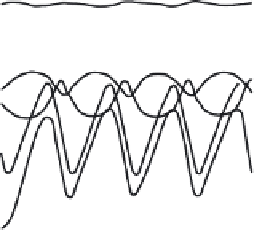Geoscience Reference
In-Depth Information
+
O
2
0.9
0.9
0.8
+
N
0.8
N
*
O
2
0.7
0.7
0.6
0.6
N
e
N
0.5
0.5
0.4
0.4
N
e
NO
+
0.3
0.3
N
*
0.2
0.2
NO
+
0.1
0.1
100
200
300
400
500
100
200
300
400
500
Time, s
Time, s
Fig. 13.4.
The ratio of an ion concentration to the corresponding background value
as a function of time for minimum (left) and maximum solar activity (right) for
τ
T
= 100 s
The results of the numerical solution of (13.6)-(13.7) for different condi-
tions of solar activity and periods of modulation
τ
T
= 10 and 100 s are given
in Fig. 13.3 (curves 1 and 2 correspond to maximum solar activity and periods
of 10 s and 100 s; curves 3 and 4 correspond to minimum solar activity and
the same periods of 10 and 100 s). Two families of curves, corresponding to
heating with 10 and 100 s modulation, are distinguished in this figure.
The time dependencies of various components of the ionospheric plasma
for the minimum and maximum solar activity in the case of 100 s modulation
are shown in Fig. 13.4. Here the normalized concentrations of the various
components of the ionospheric plasma are laid out along the ordinate axis.
Different depths of modulation for different components are seen from the
curves. The effect of nonlinearity is manifested most clearly in N
∗
and O
2
.
The curves in Fig. 13.4 are constructed for
T
1
= 2000
◦
K. Analogous curves for
10 s temperature modulation with an amplitude
T
1
= 1000
◦
Kinaperiodof
minimum solar activity are presented in Fig. 13.5 (left panel). The transitional
mode for
N
e
with a characteristic time of the order of 100 s is clearly seen
in this figure. The time dependencies of the concentrations of the various
components for the solar activity maximum are given in the right panel of
Fig. 13.5.
Summarizing the results of the calculations of chemical kinetics for the
E
-layer, we conclude that
•
the deepest modulation of concentration appears in the quasi-stationary
case;
•
100 s temperature oscillations yield a depth of modulation of
N
e
differing
by not more than two to three times from the quasi-stationary case;





























Search WWH ::

Custom Search